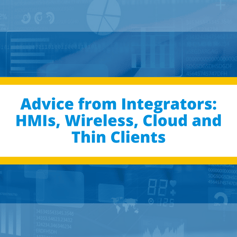 Winners of the 2017 System Integrator of the Year award were asked to provide valuable advance on system designs and technologies including HMIs, wireless, cloud, Industrial IoT, etc. so that others may get better insight and get acquainted with best practices.
Winners of the 2017 System Integrator of the Year award were asked to provide valuable advance on system designs and technologies including HMIs, wireless, cloud, Industrial IoT, etc. so that others may get better insight and get acquainted with best practices.
The people who provided their feedback included:
- Jordan Gass, Control Systems Developer
- Loren Schmidt, Senior Control Systems Developer
- Marty Van der Sloot, Division Manager, Interstates Control System
- Will Aja, Vice President of Customer Operations, Panacea Technologies
Insight on Human Machine Interface Software Design
By Jordan Gass
Human Machine Interfaces are necessary for modern systems as they provide a gateway to all the ins & outs of the system. However, a high-performance HMI is one that provides operators with critical information, required to carry out tasks safely & completely without wasting too much time. There are a few key components that gives an HMI edge over simple interfaces:
- Use of Color: Colors need to be chosen carefully as they determine the level of importance of a piece of information. Too many different colors can quickly overwhelm the operator who is likely to get confused. Colors such as red, yellow and orange are great when the operator’s attention is required, whereas a neutral color such as gray or light blue can add to the contrast of the design.
- Use of Animations: Operators are looking for information in the quickest manner possible. If too many animations are added to the HMI, it would take too many resources and distract operators from the real task at hand.
- Graphs and Sliders: Such controls are extremely easy to use and interpret compared to raw numbers that require some time to understand.
- Alarm management: The importance of various alarms should be clear and assigned according to their priority. Choosing a color scheme is extremely important as it can directly correspond to the type of risk the system is facing. This will allow operators to skim through the less relevant ones, and deal with the most vital ones.
By Loren Schmidt
The importance of standards can’t be stressed enough during the development of human machine interface. Operators coming over from another HMI can find extreme ease of use if the design is consistent with a standard. A deviation from given standards forces the operator to change his/her thinking and get accustomed to the screen. This results in slower response times, which can be detrimental during emergency situations.
By Will Aja
The evolution of ISA standards around HMIs has created ripples in the industry, especially in the process world. Process and Instrumentation Diagrams are considered as key to a high-performance HMI by process engineers, while the factors that actually need to be taken into account include operator efficiency, situational awareness and response times.
Having well-defined core requirements and desired objections can greatly smoothen the implementation of an HMI. Simply adding high-performance graphics can’t upheave an HMI’s credentials. Instead, adoption of standards can add to higher response times, even in traditional HMI layouts.
Role of Wireless & Cloud Technologies with Data Management for IIOT
By Marty Van der Sloot
The consumption of data is only increasing with the passage of time. The introduction of IIoT devices has greatly helped bring down the cost of automation systems. The major challenge of data management comprises of its collection and its storage location. Wireless technologies have opened up new avenues of communication by allowing access in places that were previously too remote or hazardous.
Data collected from these remote locations can be routed directly to cloud-based solutions. Once this happens, users are able to gain access to this data on a global scale and run analytics from any location they want.
By Will Aja
Wireless mesh network technologies have brought in an untapped dimension to our disposal. Most IT departments are wary of implementing a wireless solution due to the interference from process equipment. Lost connections are simply not acceptable to clients so wireline connections are usually preferred. But everything has changed with the onset of mesh networks. These networks allow addition of wireless access points wherever required, while simultaneously providing uninterrupted connection to the user. With time, the technology would improve and limit wired connections to core infrastructure such as OPC collectors, servers, etc.
Cloud technologies, especially hybrid cloud arena is a great solution for clients. A hybrid cloud is like having a local virtualized infrastructure that works with an offsite cloud provided for data storage. This brings in the power of remote services and combines them with a self-managed private cloud, forming a singular, powerful infrastructure.
System Integration experiences, automation, controls and instrumentation
By Will Aja
The importance and benefits of deploying SCADA systems on thin clients is reiterated project after project. The longevity of the system can be greatly increased if the hardware layer is decoupled from the server infrastructure. Doing so allows future migrations to take place in a more well-managed way. For instance, a vendor may release five different HMIs in a decade, which is something quite difficult to keep up with due to multiple migrations.
Physical custom HMIs not only carry the burden of increased costs & guzzling of resources but also have inherent security risks. One of these risks is the rejection of domain-based authentication that leave shared passwords vulnerable to entire user groups. Thin-client deployments on the other hand allow companies to keep track of operator actions and access data only after they’ve been authenticated.
The transition to thin-client systems is often seen with intimidation, but the implementation can be greatly smoothened through proper planning and evaluation of potential risks. Once the industry gets a hang of the benefits of virtualization of server infrastructure, not a single company would want to go back to their primitive systems.
Interested in learning more? Visit our website www.premierautomation.com, or talk to one of our specialists today.




